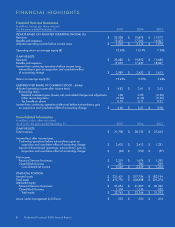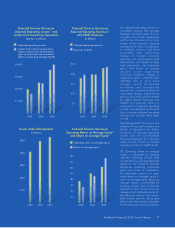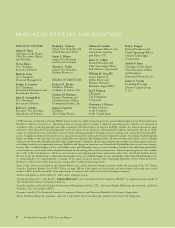Prudential 2005 Annual Report Download - page 18
Download and view the complete annual report
Please find page 18 of the 2005 Prudential annual report below. You can navigate through the pages in the report by either clicking on the pages listed below, or by using the keyword search tool below to find specific information within the annual report.Accounting Policies & Pronouncements
Application of Critical Accounting Estimates
The preparation of financial statements in conformity with accounting principles generally accepted in the United States of America,
or GAAP, requires the application of accounting policies that often involve a significant degree of judgment. Management, on an ongoing
basis, reviews estimates and assumptions used in the preparation of financial statements. If management determines that modifications in
assumptions and estimates are appropriate given current facts and circumstances, results of operations and financial position as reported in
the Consolidated Financial Statements could change significantly.
The following sections discuss the accounting policies applied in preparing our financial statements that management believes are
most dependent on the application of estimates and assumptions.
Valuation of Investments
As prescribed by GAAP, we present our investments classified as available for sale, including fixed maturity and equity securities, and
our investments classified as trading, such as our trading account assets supporting insurance liabilities, at fair value in the statements of
financial position. The fair values for our public fixed maturity securities and our public equity securities are based on quoted market prices
or estimates from independent pricing services. However, for our investments in private securities such as private placement fixed maturity
securities, which comprise 14% of our investments as of December 31, 2005, this information is not available. For these private fixed
maturities, fair value is determined typically by using a discounted cash flow model, which relies upon the average of spread surveys
collected from private market intermediaries who are active in both primary and secondary transactions and takes into account, among
other things, the credit quality of the issuer and the reduced liquidity associated with private placements. See “—Realized Investment Gains
and General Account Investments—General Account Investments—Fixed Maturity Securities—Private Fixed Maturities—Credit Quality”
for information regarding the credit quality of the private fixed maturity securities included in our general account.
For our investments classified as available for sale, the impact of changes in fair value is recorded as an unrealized gain or loss in
“Accumulated other comprehensive income (loss), net,” a separate component of equity. For our investments classified as trading, the
impact of changes in fair value is recorded within “Asset management fees and other income.” In addition, investments classified as
available for sale, as well as those classified as held to maturity, are subject to impairment reviews to identify when a decline in value is
other than temporary. Factors we consider in determining whether a decline in value is other than temporary include: the extent (generally
if greater than 20%) and duration (generally if greater than six months) of the decline; the reasons for the decline in value (credit event or
interest rate related); our ability and intent to hold the investment for a period of time that will allow for a recovery of value; and the
financial condition and near-term prospects of the issuer. When it is determined that a decline in value is other than temporary, the carrying
value of the security is reduced to its fair value, with a corresponding charge to earnings. This corresponding charge is referred to as an
impairment and is reflected in “Realized investment gains (losses), net” in the statements of operations. The level of impairment losses can
be expected to increase when economic conditions worsen and decrease when economic conditions improve. See “—Realized Investment
Gains and General Account Investments—Realized Investment Gains” for a discussion of the effects of impairments on our operating
results for the years ended December 31, 2005, 2004 and 2003.
Commercial loans, which comprise 11% of our investments as of December 31, 2005, are carried primarily at unpaid principal
balances, net of unamortized premiums or discounts and an allowance for losses. This allowance includes a loan specific portion as well as
a portfolio reserve for probable incurred but not specifically identified losses. The loan specific portion is based on management’s
judgment as to ultimate collectibility of loan principal. The portfolio reserve is based on a number of factors, such as historical experience
and portfolio diversification. Adjustments to the allowance are reflected in “Realized investment gains (losses), net,” in our statements of
operations. Similar to impairment losses discussed above, the allowance for losses can be expected to increase when economic conditions
worsen and decrease when economic conditions improve. See “—Realized Investment Gains and General Account Investments—General
Account Investments—Commercial Loans—Commercial Loan Quality” for a discussion of the effects of the valuation allowance on our
operating results for the years ended December 31, 2005 and 2004.
See “—Realized Investment Gains and General Account Investments—General Account Investments” for a discussion of our
investment portfolio, including the gross unrealized gains and losses as of December 31, 2005, related to the fixed maturity and equity
securities of our general account, our policies and procedures regarding the identification of other than temporary declines in investment
value, and the carrying value, credit quality, and allowance for losses related to the commercial loans of our general account.
Policyholder Liabilities
Future Policy Benefit Reserves, other than Unpaid Claims and Claim Adjustment Expenses
We establish reserves for future policy benefits to or on behalf of policyholders in the same period in which the policy is issued. These
reserves relate primarily to the traditional participating whole life policies of our Closed Block Business and the non-participating whole
life, term life, and life contingent structured settlement and group annuity products of our Financial Services Businesses.
The future policy benefit reserves for the traditional participating life insurance products of our Closed Block Business, which as of
December 31, 2005, represented 50% of our total future policy benefit reserves, are determined using the net level premium method as
prescribed by GAAP. In applying this method, we use mortality assumptions to determine our expected future benefits and expected future
premiums, and apply an interest rate to determine the present value of both the expected future benefit payments and the expected future
premiums. The mortality assumptions used are based on data from the standard industry mortality tables that were used to determine the
Prudential Financial 2005 Annual Report16
























